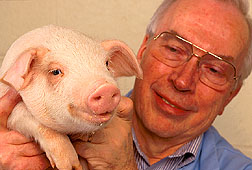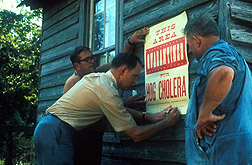|

Click image for caption and other photo
information.
Details:
Improvements in sex sorting (1999)
|
ARS Hall of Fame Inducts Three
Scientists By
Jim Core
November 28, 2001
BELTSVILLE, Md., Nov. 28--Pioneering research toward
improving soil quality, research contributions and leadership in the field of
swine viral diseases, and the development of technology for gender preselection
of mammals have earned their developers places in the Agricultural Research
Service Science Hall of Fame. ARS is the
chief research agency of the U.S. Department of
Agriculture.
The inductees--soil scientist William E. Larson, swine
virologist William L. Mengeling and research scientist Lawrence A.
Johnson--will receive plaques citing their diverse achievements. Permanent
copies of the plaques presented to the scientists will be on display at
ARS’ National Visitor
Center in Beltsville, Md.
Since 1986, the ARS Science Hall of Fame program has recognized
agency researchers for outstanding career achievements in agricultural science.
Those inducted are nominated by their peers for making major contributions to
agricultural research. The scientists must be retired or eligible to retire to
receive the honor.
William Larson worked for ARS and its predecessor agency for 32
years before retiring in 1982 as the research leader at the
Soil and Water Management Research
Unit in St. Paul, Minn., and technical leader for Tillage/Residue
Management Investigation.
Larson developed a theory of soil compressibility that was used
in a model used around the world to describe soil compaction resulting from
farm machinery wheel traffic. Also, his studies demonstrated that biosolids
could be used safely in agricultural land without contaminating food products
and water. |
|

Government
officials post a cholera quarantine notice on a farm bulding--a frequent
occurrence wherever this disease erupted in the U.S.
 Details: The long struggle to understand and
eradicate hog cholera. Details: The long struggle to understand and
eradicate hog cholera.
|
William Mengeling joined ARS in 1961 as a veterinary research
virologist at the National Animal
Disease Center in Ames, Iowa. During his early career, he developed a
diagnostic test which was the primary test used in eradicating hog cholera from
U.S. swine herds. The United States was declared free of hog cholera in 1978,
saving the swine industry more than $100 million annually.
Mengeling was the first scientist to isolate porcine parvovirus
from swine in the United States. He established under both laboratory and field
conditions that this virus plays a role in maternal reproductive failure of
swine. Mengeling’s research provides a basis for enhanced understanding of
several other swine diseases, including pseudorabies and porcine reproductive
and respiratory syndrome (PRRS).
Lawrence Johnson developed a patented procedure, known worldwide
as the USDA-Beltsville Sperm Sexing Technology, that is the only method
validated for gender-preselection in mammals. This invention has given the
livestock industry the ability to pre-select the gender of offspring in their
livestock breeding herds for the first time.
Johnson worked in Beltsville from 1964 until his retirement in
January 2000 from the Animal and
Natural Resources Institute’s
Germplasm and Gamete
Physiology Laboratory. Earlier in his career, Johnson collaborated with
another ARS scientist to develop the first successful method of deep-freezing
swine semen for use in the commercial artificial insemination of swine. Later,
he and Dutch scientists collaborated to develop a semen extender, the
Beltsville Thawing Solution, that is now used for more than 15 million
inseminations of swine throughout the world each year. |